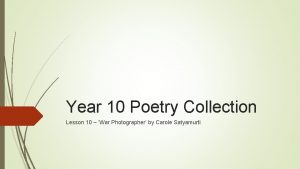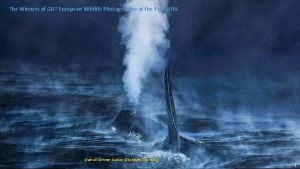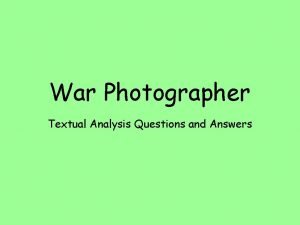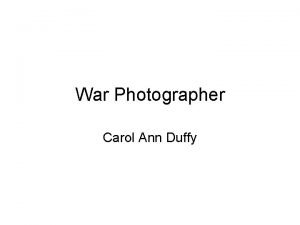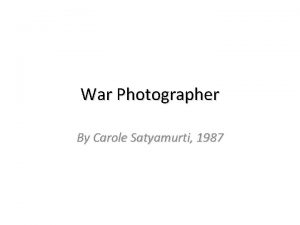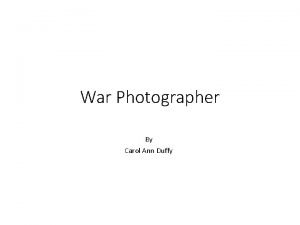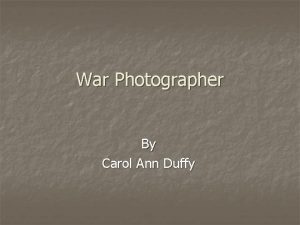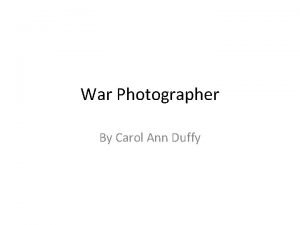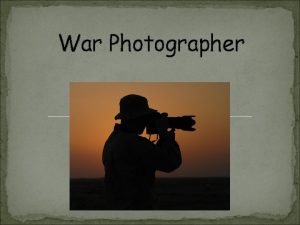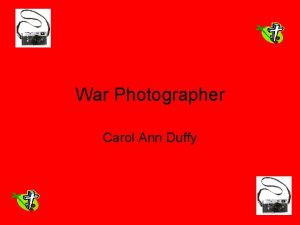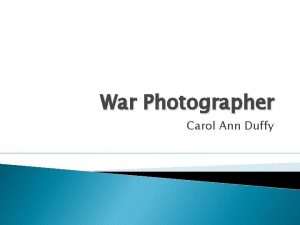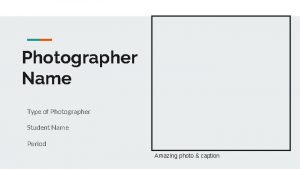Year 10 Poetry Collection Lesson 10 War Photographer









- Slides: 9

Year 10 Poetry Collection Lesson 10 – ‘War Photographer’ by Carole Satyamurti

Learning Objective To appreciate how Satyamurti uses language and imagery drawing parallels and contrasts to characterise a war photographer. Outcomes: You MUST annotate your poem independently with as much info as possible. You will need this for your revision next year. Anything you miss, it is your responsibility to catch up/complete Flipped Learning

Read and listen First impressions? What is it about? Repeated ideas? Tone? Message? Words – specific/interesting/unusual? Alliteration or other devices? Rhyme and rhythm? Structure?

Glossary prevailing taking over, taking charge arbitrary random, without reason or judgement

Exploring the poem… Poet British and sociologist – lives and works in London What are these pictures of? Professional photographers cover different events and topics. Poem is about a photographer who took a photo of a vulnerable child carrying a baby in a conflict zone. The disturbing aftermath is not captured.

Exploration… Impression of photographer? Sensitive Professional Optimistic Emotional Find quotations to support these impressions. Which one comes across strongest? Different impressions in different sections?

Contrasts and comparisons? Linguistic and semantic parallels and contrasts within the poem? Where? Why? (Different depictions in stanza 2 and 3 – why? ) Look at last stanza – contrasting images and word choices there. Why? Impact of this? Objective of a war photographer – should they have emotional response? Reporting only? How can you remain detached? Does the narrator do this here?

Consolidation How does Satyamurti present the attitude of the war photographer to the subjects of their photos. Comment on: - clues to character and viewpoint - the language of parallels and contrasts - use of graphic imagery Two paragraphs, please.

Peer assessment Are they using correct terminology? Are they using appropriate quotations? References to language, structure and form? GCSE Mark Scheme for Paper 2 Section B Level 1 Identification of language, form and structure is minimal. Little evidence of relevant subject terminology. Level 2 There is some comment on the language, form and structure of the text. Limited use of relevant subject terminology to support examples given. Level 3 The response shows an understanding of a range of language, form and structure features and links these to their effect on the reader. Relevant subject terminology is used to support examples given. Level 4 Analysis of language, form and structure features and their effect on the reader is sustained. Relevant subject terminology is used accurately and appropriately to develop ideas. Level 5 The response is a cohesive evaluation of the interrelationship of language, form and structure and their effect on the reader. Relevant subject terminology is integrated and precise.
